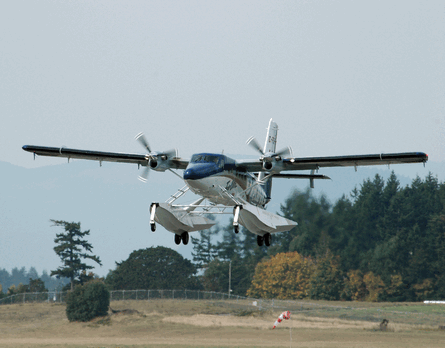The "other" maker of large aircraft in Canada is in the final throes of completing a home-grown update to the country's venerable indigenous workhorse - the de Havilland Twin Otter.
By July, Viking expects to complete certification of its $4.5 million DHC-6 Twin Otter Series 400, complete with more than 200 upgrades from the original Twin Otter, last produced by then certificate holder Bombardier in 1988. Viking purchased the type certificate for the Twin Otter and six other de Havilland aircraft from Bombardier in February 2006, restarting the Twin Otter line a year later. More than 600 of the 844 Twin Otters built between 1965 and 1988 are still flying.
The most noticeable change in the new aircraft is the Honeywell Primus Apex integrated avionics suite, featuring two primary and two multifunction active matrix LCDs. It is the cockpit that is slowing progress. Viking president and chief executive David Curtis says the "longest pole" in the certification tent is the Apex flightdeck due to the time required to set the equipment in place that will convert more than 200 of the aircraft's analogue control signals to digital, the language of the integrated flightdeck.
 |
|---|
© Viking AirViking's $4.5 million DHC-8 Twin Otter Series 400 has more than 200 upgrades from the original |
The company in May was in the process of installing the conversion equipment, a series of Honeywell digital acquisition units, into the certification aircraft.
But slow-going is the recipe for the Vancouver Island-based company of 370 employees. Curtis says his steady state production rate of one aircraft a month by next year is "not an overwhelming rate, but one we can handle and achieve comfortably". There is a downside, however. "Our biggest challenge is backlog with respect to production rate," says Curtis. "People don't want to wait two and a half years, but we need to walk before we can run."
Curtis says he maintains an orderbook of 40 orders, including options, and the economy has not resulted in cancellations. Neither have delivery slots slipped, although heis "being fairly patient on progressive payments".
As for parts sales for the existing de Havilland fleet, he says he has seen a "fluctuation" as flight hours have decreased. "Our timing from the perspective of the aircraft going into service will fit well with the economic improvement expected to take place in early 2010," he adds.
Curtis plans to deliver five of the Pratt & Whitney Canada PT6A-34-powered twin-engined turboprops this year, the first four of which are in the final assembly plant and customer delivery centre in Calgary, Alberta. The Canadian government in part is helping to put wind beneath the wings of the Twin Otter. Curtis says the "first four or five" Twin Otters are likely to be financed by the Canadian Export Development Corporation.
By August, Curtis plans to have most of the Viking 400 engineering work complete, meaning the dozens of engineers assigned to the programme will be ready for a new assignment. "We're playing around with what's next," says Curtis, offering a hint - "Buffalo?"
Story updated on 18 May 2019 to correctly reference the Twin Otter as the DHC-6.
Source: Flight International



















